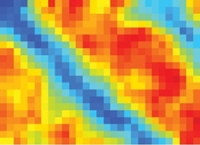Graphene’s behaviour depends on where it sits
By By David L. Chandler, MIT News Office | 14 Aug 2012
When you look at a gift-wrapped present, the basic properties of the wrapping paper - say, its colours and texture - are not generally changed by the nature of the gift inside.
 |
| An image (made with Raman spectroscopy) of a graphene layer on top of a patterned substrate shows the difference in chemical reactivity of the side opposite the substrate. The wide red stripe is an area over a silicon dioxide substrate, making the top surface of the graphene highly reactive. The narrow blue stripe is graphene over a layer of hydrocarbon (called OTS), and there is almost no reactivity on the side not in contact with the substrate. Image courtesy Wang et al, from Nature Chemistry |
But surprising new experiments conducted at MIT show that a one-atom-thick material called graphene, a form of pure carbon whose atoms are joined in a chicken-wire-like lattice, behaves quite differently depending on the nature of material it's wrapped around.
When sheets of graphene are placed on substrates made of different materials, fundamental properties - such as how the graphene conducts electricity and how it interacts chemically with other materials - can be drastically different, depending on the nature of the underlying material.
''We were quite surprised'' to discover this altered behavior, says Michael Strano, the Charles and Hilda Roddey Professor of Chemical Engineering at MIT, who is the senior author of a paper published this week in the journal Nature Chemistry. ''We expected it to behave like graphite'' - a well-known form of carbon, used to make the lead in pencils, whose structure is essentially multiple layers of graphene piled on top of each other.
But its behaviour turned out to be quite different. ''Graphene is very strange,'' Strano says. Because of its extreme thinness, in practice graphene is almost always placed on top of some other material for support. When that material underneath is silicon dioxide, a standard material used in electronics, the graphene can readily become ''functionalised'' when exposed to certain chemicals. But when graphene sits on boron nitride, it hardly reacts at all to the same chemicals.
''It's very counterintuitive,'' Strano says. ''You can turn off and turn on graphene's ability to form chemical bonds, based on what's underneath.''













.jpg)






.jpg)









